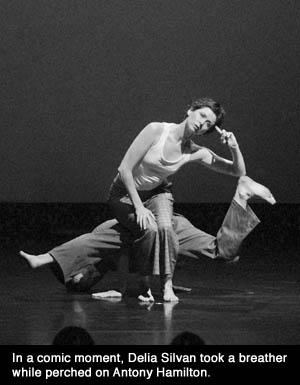Simply Accessible
Want to Dance Better at Parties, presented by Chunky Move. At UCSB's Campbell Hall, Wednesday, March 14

It’s a simple enough statement: “I want to dance better at parties.” It’s also a simple premise: take five men’s description of the role of dance in their lives and tell those stories on a stage using professional dancers. The result is a work that’s deceptively simple-at moments almost painfully literal, and also satisfyingly sophisticated in its simplicity.
For this piece, choreographer and Chunky Move Artistic Director Gideon Obarzanek started out intending to make a documentary before deciding to stage a live work instead. From those he interviewed for the documentary, he narrowed the pool to five men whose stories he felt he could translate into his own theatrical language. The six dancers performing I Want to Dance Better at Parties-four men and two women-impersonate these five men in turn. At first, as film footage of each interviewee appears on screen and their voices are projected, the corresponding dancer mimics that man’s movement-or lack thereof, in the case of one reluctant subject who says of dancing, “I just avoid it at all costs.” Long-legged, wiry Kristy Ayre dances the part of Lindsay, an avid tap dancer who tells of losing his partner of 10 years to another man in his clogging group, while the compact, quicksilvery Antony Hamilton embodies Phillip, the fifty-something, recently widowed single father who tells of explaining to a sexy, female ballroom dance instructor, “I want to learn to dance better at parties.”
As the piece begins to drift from direct mimicry to more metaphorical interpretations of the stories, Hamilton floats onstage with arms held high and shoulders raised to his ears, then exhales loudly and collapses like a deflating balloon. Set to the dancers’ inhalations and exhalations, and cut through with the melancholy strains of experimental electronica duo Pretty Boy Crossover, it’s a mesmerizing, abstract interpretation of Phillip’s grief. Niklas Pajanti’s lighting casts the dancers into striking grayscale against a blood-red scrim, illuminating their heaving chests.
Mesmerizing, too, is a torturous scene in which one dancer stands motionless in the role of Franc, the non-dancer, while the others writhe around him, grabbing at his clothing to force him to dance. The metaphor for Lindsay’s betrayal has dancers hyperventilating as they thrash their limbs through space, and then flopping across the floor like fish on dry land, desperate and wretched. Ultimately, Obarzanek never strays far from his starting point, and it’s his willingness to stick to the storyline that makes this work so accessible.



